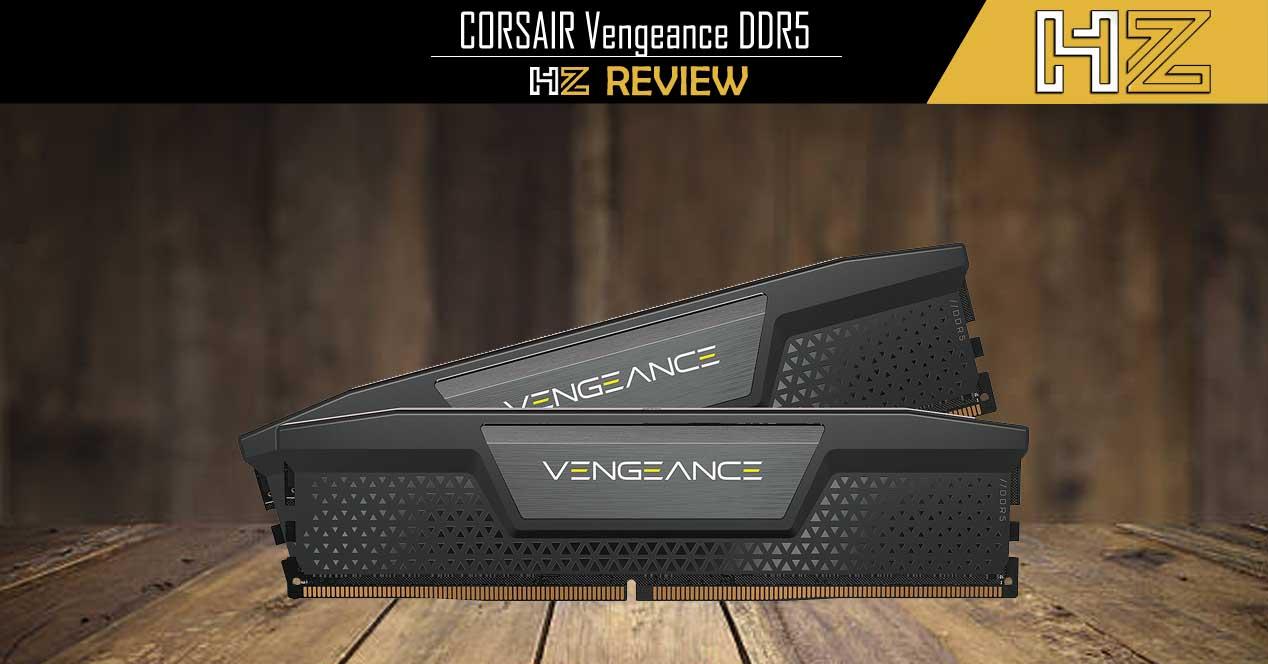As you already know, being DDR5 memory, we are facing a kit that has an XMP 3.0 profile, as well as integrated voltage control on the PCB of each module, so consumption and temperature will not only be lower, but also more controlled thanks to the software, in this case CORSAIR iCUE.
Unboxing and external analysis
Instead of coming in fancy packaging like we’ve seen with the Dominator Platinum RGB family, the Vengeance DDR5s come in a simple yellow and black soft cardboard packaging, with a picture of one of the memory modules on the front accompanied by the make, model and capacity.


As usual, on the back of the package we find information in different languages and “windows” that allow us to see the labels of the two memory modules.
Inside, apart from the two modules protected by a transparent plastic blister, we only have a small brochure with safety information.
Here we have the two CORSAIR Vengeance DDR5 modules out of the box, in this case in black (they are also available in white). As you can see the aluminum heatsink is low profile, it comes with a sort of lattice on the bottom and the VENGEANCE logo adorning the center.
Here you take a closer look at this detail with the model name.
On the opposite side they are identical, but instead of the logo we have the rigorous identification label.
They are memories that, as we have already said, have a low profile and will allow us to use them even with the largest CPU coolers on the market. They’re simple, almost minimalistic, but the heatsinks give them a really good quality feel, as they make the modules feel sturdy.
By the way, on the sides we can see a detail that indicates that they are DDR5 memory modules, since aesthetically they are identical to the previous generation.
At the top we simply have an ornament with the brand logo.
The radiator of these memories itself (that is, if we measure omitting the connector part) only raises them by 30.1 mm. Low profile, but low.
In addition, the exact thickness of 7 mm of these memories means that they are not too close to each other when installing the modules together, so that air can pass between them to cool their heatsinks.
After seeing the memories, we will proceed to install them on our test bench to test their performance. And in doing so, although the heatsink used does not cover the memory sockets, it is clear that we could install it without problems even if it were, even without having to raise the fan a few millimeters and to l press RAM. Enter in abundance.
Tests and performance: here’s how the CORSAIR Vengeance DDR5 works
To test these CORSAIR Vengeance DDR5 we used our Intel Alder Lake-S test bench, in this case equipped with the Intel Core i5-12600K processor and composed of the following hardware:
- Intel Core i5-12600K.
- ASUS Prime Z690-A.
- NH-D15 Owl.
- Be quiet! Pure power 11 FM 1000W.
- TeamGroup Cardea A440 Pro 2TB.
For testing, we used Windows 11 as the operating system, updated to date with all automatic updates. We also used the CORSAIR iCUE software in its latest version, in this case v4.24.193. In addition, you should know that before installing these memory modules we already had the XMP profile activated in the BIOS of the motherboard, we did not have to do any additional configuration and from the start the memories worked at 5600 MHz without any problems. although we installed some 5200 MHz before).
In the following screenshot of CPU-Z we can see the hardware used to test the memories, and an interesting fact is that this software also detects that the DRAM chips used by these memories are manufactured by Samsung (in these same Vengeance but with lower speeds, the chips are made by Micron).
After having seen this part, we will start with what iCUE, the unified software of CORSAIR, offers us. Right from the start and without having to touch anything, the software perfectly detects the memories and gives us access to its configuration.
Of course, since these RAMs do not have lighting, this section is not available and we can only access the monitoring section. Here we can see both the temperature, consumption and voltages of the memory modules; The promised update is still pending, which would allow us, in theory, to be able to modify the XMP 3.0 profile and with it the RAM settings directly from the software without having to go through the BIOS.
In the alerts section, as always, what we can do is configure what we want to happen when the temperature reaches a certain point, such as turning on all the system LEDs in red, running a program or turning off the ‘computer.
Given what the software offers us, we are now going to see how these memories behave.
Aida64
With this benchmark, we will measure the performance of raw memory in read, write and copy tasks with the processor.
We can see that the performance of these memories at 5600 MHz is excellent, much better than the Dominator Platinum RGB that we tested at 5200 MHz, although it is true that they are well below other RAMs that worked at 6400MHz. The speed of DDR5 RAM greatly affects its performance in this type of benchmark.
Super Pi
This benchmark forces the processor to calculate the decimals of the number Pi, a task that requires intensive performance in RAM memory because the results are saved directly there. In this case, we perform the calculation test of 32 million decimals.
The result is as expected, better than with the 5200 MHz memories but worse than that obtained with the 6400 MHz RAM. What is clear is that despite having a lower range than the Dominator Platinum RGB, these Vengeance DDR5 give us They deliver outstanding performance.
WPrime
This benchmark is very similar to the previous one, although it uses a different algorithm and also uses 4 processor threads in parallel, so the result is much faster than that obtained with SuperPi. For this reason, we will use the calculation of the 32 million decimals but also that of the 1.024 million.
Again, the result here is as expected, and although the times in the Vengeance DDR5 are higher than the others, this is to be expected, since we used a Core i5-12600K and in the other two cases a Core i9- 12900K. If the same processor had been used, the result would have been between the other two, just like in previous benchmarks.
WinRAR
The famous file compression and decompression software also has its own benchmark, and although again the power of the processor is the most influential here, the RAM memory also has a lot to do with it because information is constantly sent and collected from the memory during file compression and decompression operations.
The result is excellent. To give you an idea, an Intel Core i7-8700K with 3600 MHz CORSAIR Dominator Platinum RGB DDR4 scores 17,757 KB/s in this test.
7Zip
As in WinRAR, in this benchmark we will see the power of the PC with compressed files, both to compress and decompress, but logically using 7Zip’s own algorithms on this occasion.
Similar to what’s happened to us in other DDR5 RAM reviews, the results of this benchmark are stratospheric, with absolutely incredible performance that makes us think that maybe 7Zip isn’t ready for DDR5 anymore. because it is not able to measure performance properly.
Conclusion and judgment
The new generation of DDR5 RAM has been around for a while now, and it’s certainly here to stay despite the fact that at the moment we can only use it with Intel’s new Alder Lake-S platform (it’s won’t be long before we see the next gen. both from Intel and AMD, both with this memory). The increase in performance it offers us compared to the previous generation is overwhelming and, in addition, much more stable and with less consumption. The only problem, you already know which one it is, and it is much more expensive (although it is true that we now find at least 32 GB kits).
These CORSAIR Vengeance DDR5 RAMs showed us during our analysis that we don’t need to have a high-end product to enjoy excellent performance, and that is that they performed exceptionally well in all tests to which we have subjected them, delivering a level of performance well above average and, above all, very stable at all times.
In addition, these memories are ideal for users who seek the best performance while maintaining a low profile that allows the installation of large CPU heatsinks, in addition to a sober and minimalist aesthetic without lighting, because not everyone don’t like having a PC full of colored lights.
For all these reasons, we believe that these CORSAIR Vengeance DDR5s deserve our Gold Award, as well as our recommendation both for their performance and for their design, which we find sublime.

































